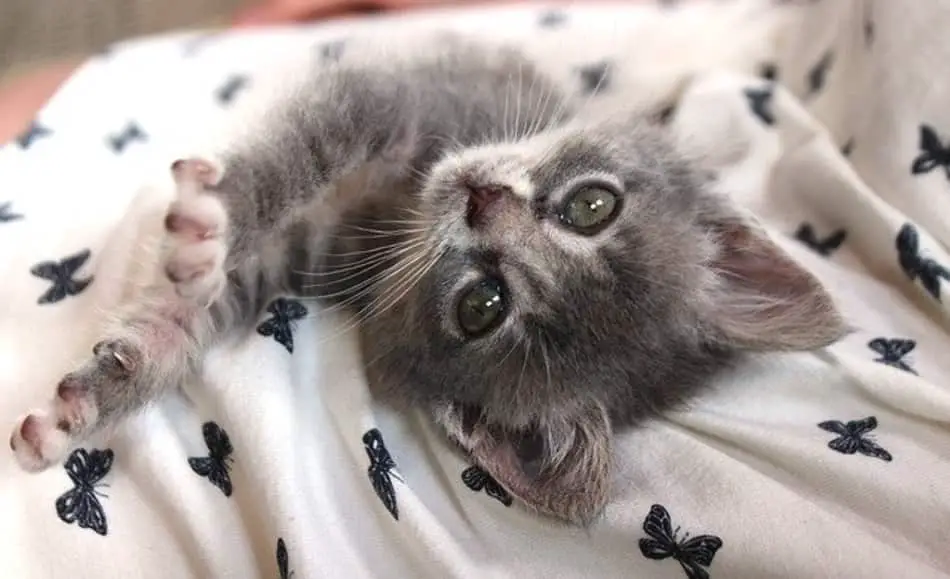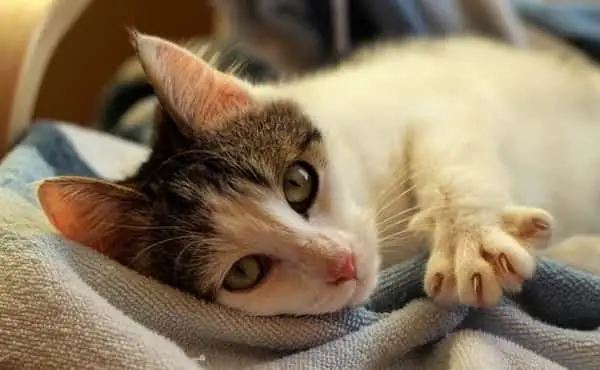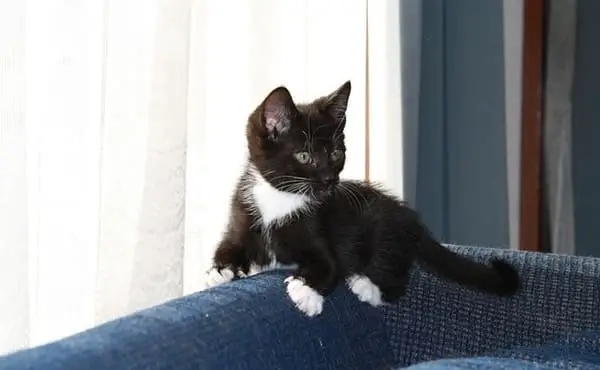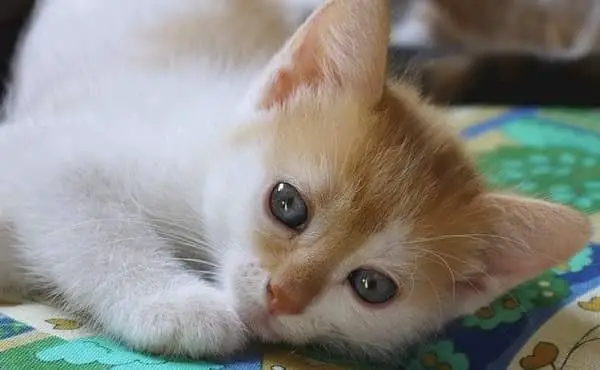Kittens come into the world equipped with 18 razor-sharp claws intended to support almost every one of their activities. A kitten’s retractable claws will come in handy for climbing, catching prey (or toys), and defending itself throughout its life. Most kittens learn how to manage these sharp little tools fairly quickly, but some may struggle with a few claws that seem to catch on everything.
So, why do my kitten’s claws get stuck in everything? Kitten claws are exceptionally fine and therefore very sharp. Additionally, very young kittens may not have learned how to retract their claws to keep them out of the way when they’re not needed. Claws in need of a trim are also much more prone to catching.
This article takes a deep dive into cat claw maintenance, explaining why your kitten’s claws are prone to snagging, why this is dangerous, and how to address it. It will also take a quick look at a once common option for stopping the snag, declawing, and explain why it’s no longer generally recommended.
Hazards of Snagging
The hazards of constantly snagging kitten claws are many. Sticky claws present a danger to your kitten, you, and every piece of furniture and clothing your kitty has access to. For this reason, claws that catch on everything are more than just an annoyance and should be taken care of.
Dangers to Your Kitten
Snagging claws are most dangerous for your kitten. If a claw gets stuck while it is jumping from one place to another, it can be torn off, which is both painful and likely to bleed. Recalcitrant claws can also lead to a kitten tripping, falling, or getting stuck in awkward to dangerous positions. Finally, a claw that catches on your clothing can lead to a kitten being dragged or stepped on.
Dangers for You
Claws that are constantly getting stuck in things are usually extra sharp and splintery. These sharp and splintery claws can lead to some nasty scratches for you or other pets, and cat scratches are known for getting infected or causing allergic reactions. Moreover, if your kittens’ claws keep getting stuck in your clothing, they may panic, leading to more painful scratches or bites.
Dangers for Furniture and Clothing
The danger of claws that constantly snag to your furniture and clothing is self-explanatory. Besides possibly injuring or panicking your kitten, if its claws snag on furniture or clothing, it could scratch, tear, or otherwise disfigure the material.
Reasons for Constant Snagging
Despite their sharpness, a kitten’s claws are retractable and should not constantly be catching on things. There are several reasons that could be behind this anomaly, most of them having to do with what kind of shape your kitten’s claws are in and whether or not it is able or willing to retract them.
Claws That Need Trimmed
If they are not properly cared for, a kitten’s claws may become uneven, needle sharp, and splintery, causing them to catch on everything. Most cats learn to care for their own claws if they are provided with a proper scratching post.
Scratching their claws on this post sharpens the claws, but it also trims off old husks and splinters, making them less likely to snag. However, some kittens may not have developed good claw care habits, causing their claws to become overgrown, rough and prone to snagging.
Youth and Inexperience
Cat claws are retractable, meaning a cat can partially withdraw them when it is relaxed. This makes them less likely to scratch or snag on things the cat doesn’t want to. Kittens usually learn to retract their claws through trial and error and often through interacting with their mother and siblings.
A very young kitten, or one that was raised alone, may not have learned to retract its claws yet, causing them to snag more frequently.
Anxiety or Excitement
A kitten may also choose not to retract its claws if it is in a playful or anxious mood. If it is feeling playful, it may want to grab and catch everything, and its claws will be all the way out. If it’s anxious, it may feel that it needs to protect itself, causing it to tense up and keep its claws at ready.
Inability to Retract
Occasionally, a kitten may be unable to retract its claws. Usually, it is only one or two claws that are affected, but these little rebels can do a lot of snagging and sticking. You may be able to see these claws when your kitten is walking or hear them clicking on a hard floor. Unretractable claws may be the result of trauma or infection in your kitten’s past.
How to Stop Kittens from Using Claws
Fortunately, there are several ways you can stop your kitten’s claws from catching on everything, no matter what reason is behind it. These fixes are all simple, inexpensive, and should not be difficult to implement.
Get a Scratching Post
If your kitten does not have a scratching post, investing in one is the best way to encourage them to take care of their claws themselves. Once they’ve gotten a feel for a scratching post, most kittens find it irresistible. You can purchase a scratching post or make one yourself using simple, easy-to-find materials like boards, pvc pipe, carpet, and/or sisal rope.
If your kitten has a scratching post, but doesn’t use it regularly, make sure it is in an easy-to-access location. It can also help to have more than one post available. Encourage your kitten to use the post by rubbing it with a bit of catnip and praising them when they show interest.

Trim Your Kitten’s Claws
If your kitten still hasn’t figured out how to care for its claws itself, or if it has one or two that won’t retract, you may need to trim them yourself. Besides snagging on everything, overgrown claws can become ingrown or cause your kitten to have difficulty walking, so it’s a good idea to regularly check your kitten’s claws in case it needs a trim.
Kitten claws are tiny and fairly fragile. You can get clippers specifically for cats, you can also trim them with regular fingernail clippers. Just take the tip off of each claw, making sure not to cut too much off, so you won’t hit the quick, which can be painful and cause bleeding.
Trimming your kitten’s claws will be easier if you often practice having it relax while you handle its toes or have a trusted friend help you.
Nail Caps
You can also purchase rubber or plastic tips that can be glued onto your cat’s claws to make them less sharp. This may be a fix to consider if your kitten often doesn’t retract its claws when playing or as a temporary solution. Most cats are fine with these tips, although some may find them annoying.
Why Declawing is Not the Answer
Declawing used to be common practice for indoor cats, but it is no longer recommended by experts and is even banned in some countries.
Although this procedure may seem like an easy, harmless fix to kitten claws that are always catching or scratching things they shouldn’t, it has multiple drawbacks and can negatively affect your kitten’s health and behavior for the rest of its life.
Lameness, Infection, and Back Pain
Declawing is far more than a permanent trim. In order to keep claws from growing back, the final bone in each toe is surgically removed. This can cause intense pain long after the surgery, may lead to infection, and will even change the way your kitten walks, often causing lameness or back pain.
Litter Box Avoidance, Biting, and Clumsiness
Kittens without claws may also stop using the litter box due to difficulty and pain associated with digging. They may become biters since they no longer feel protected by their claws. Finally, a declawed kitten tends to be clumsier since it is no longer able to use its claws for balance and to hold onto things when it’s jumping about.
Naturally agile animals, a kitten is in danger of suffering severe falls without it’s natural catching mechanisms.
Tendonectomy
Another surgical method occasionally used to deal with constantly catching or scratching claws is tendonectomy, which severs the tendons a kitten uses to flex its claws, causing them to be permanently retracted.
Ironically, this can actually lead to more problems with snagging as claws tend to grow thicker and do not wear off naturally. Lameness, infection, and bleeding also occurs as frequently with a tendonectomy as it does with declawing.
Conclusion
Constantly snagging claws are an issue that most kittens will grow out of as they learn to trim their own claws on a scratching post and retract them when they’re not using them. Usually, all you’ll need to do in the long run is be sure to provide a scratching post and perhaps help your kitten learn to use it.
In the meantime, you can minimize the damage done by trimming your kitten’s claws yourself or applying rubber tips. Regularly checking your kitten for overgrown claws is a sound routine, and some kittens, such as those with claws that will not retract due to trauma, may need regular trims or rubber tips for one or two claws.




